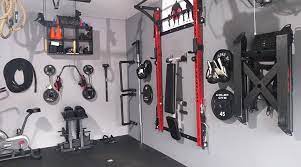Introduction
With busy schedules and limited time, finding the motivation to hit the gym can be a challenge for many. That’s where the convenience of a home gym comes in. Creating a dedicated workout space in your home not only eliminates the need for commuting but also provides privacy and flexibility to exercise on your own terms. In this article, we’ll explore space-saving solutions for setting up a home gym that maximizes efficiency without sacrificing functionality.
Assessing Available Space
Before diving into the world of home gym equipment, it’s essential to assess the available space and layout of your home. Whether it’s a spare bedroom, garage, or even a corner of the living room, determining the dimensions and configuration of your workout area will help guide your equipment selection and storage solutions. Look for unused or underutilized spaces that can be repurposed for fitness purposes, such as closets or alcoves.
Choosing Space-Saving Equipment
When it comes to selecting equipment for a home gym, opt for compact and versatile pieces that offer a full-body workout without taking up too much space. Look for foldable or collapsible options that can be easily stored when not in use, such as folding treadmills, portable exercise bikes, or adjustable dumbbells. Consider multifunctional equipment, like resistance bands or suspension trainers, that can target multiple muscle groups with one device.
Maximizing Vertical Space
In a small home gym, every square inch counts, so make use of vertical space for storage and exercise equipment. Install wall-mounted racks or shelves to store weights, yoga mats, and other accessories off the floor and out of the way. Consider investing in foldable or collapsible exercise equipment, such as wall-mounted pull-up bars or suspension trainers, that can be easily tucked away when not in use, freeing up valuable floor space.
Optimizing Dual-Use Spaces
For those with limited square footage, transforming multipurpose rooms into workout areas is a smart solution. Convert a spare bedroom or home office into a dedicated exercise space by incorporating space-saving furniture, like a wall-mounted Murphy bed or foldable desk. Invest in furniture with built-in exercise equipment, such as a coffee table with integrated resistance bands or a sofa with attached exercise pedals, to seamlessly blend fitness into your everyday routine.
Organizing Accessories and Supplies
Keeping workout accessories and supplies organized is essential for maintaining a clutter-free home gym. Utilize storage bins, baskets, and containers to corral smaller items like jump ropes, kettlebells, and yoga blocks. Labeling bins and shelves can help streamline the organization process and make it easier to find what you need during workouts. Consider investing in a multi-compartment gym bag or rolling cart to transport equipment between storage and workout areas.
Creating a Motivating Atmosphere
Designing a home gym that inspires and motivates you to exercise is key to staying consistent with your fitness routine. Adding mirrors to one or more walls can create the illusion of space and help you check your form during workouts. Incorporate motivational decor and artwork, such as inspirational quotes or photos of your fitness goals, to keep you focused and driven. Don’t forget to include ample lighting and ventilation to create a bright and energizing environment for workouts.
Utilizing Technology for Guidance
Technology can be a valuable tool for enhancing your home workout experience. Access virtual workout programs and apps that offer guided workouts tailored to your fitness level and goals. Consider investing in smart fitness equipment, such as treadmills or stationary bikes with built-in screens, that provide interactive workouts and real-time performance tracking. Integrating technology into your home gym not only adds variety to your workouts but also helps you stay accountable and motivated.
Establishing a Workout Routine
Once your home gym is set up and equipped with everything you need, it’s time to establish a workout routine that fits your schedule and goals. Set realistic fitness goals for yourself, whether it’s losing weight, building muscle, or improving endurance, and create a workout plan that aligns with those objectives. Schedule regular workouts into your daily or weekly routine, treating them as non-negotiable appointments with yourself. By prioritizing consistency and commitment, you’ll be well on your way to achieving your fitness goals from the comfort of home.
Conclusion
In conclusion, creating a home gym doesn’t have to be complicated or expensive. With careful planning and strategic use of space-saving solutions, you can transform even the smallest corner of your home into a functional and motivating workout space. By choosing compact and versatile equipment, maximizing vertical space, optimizing dual-use spaces, and incorporating technology and organization, you can create a home gym that fits your lifestyle and helps you stay active and healthy.
